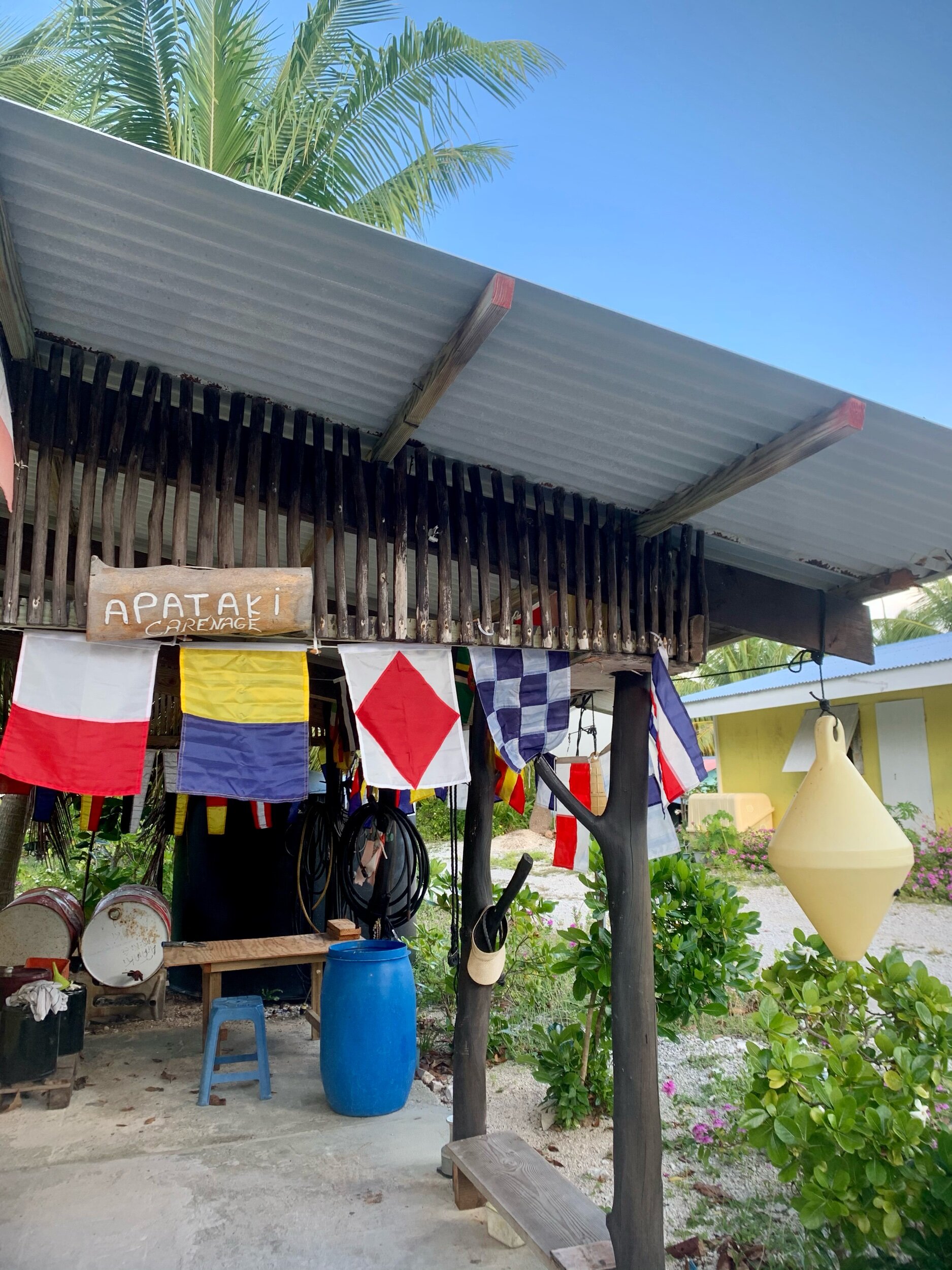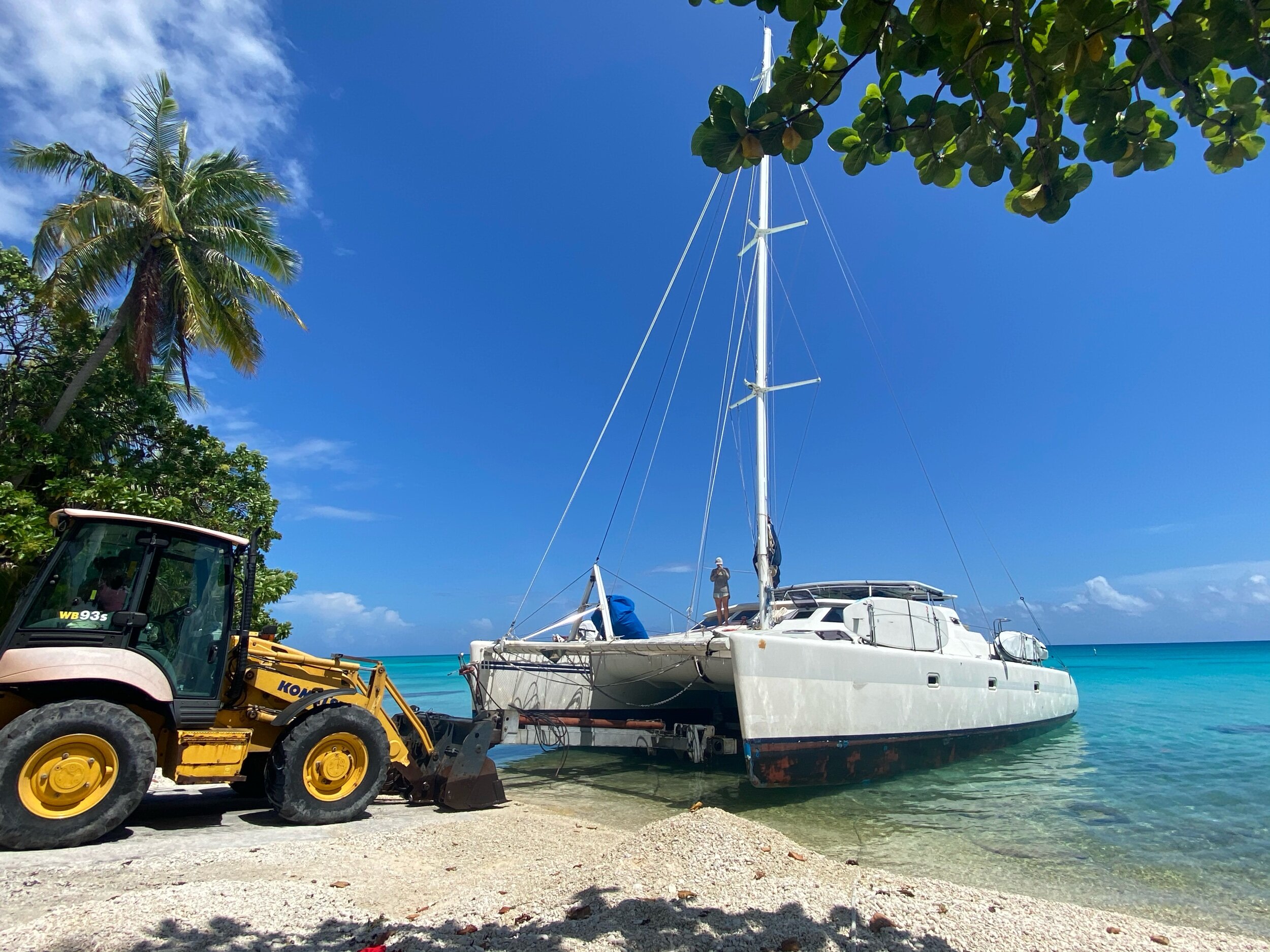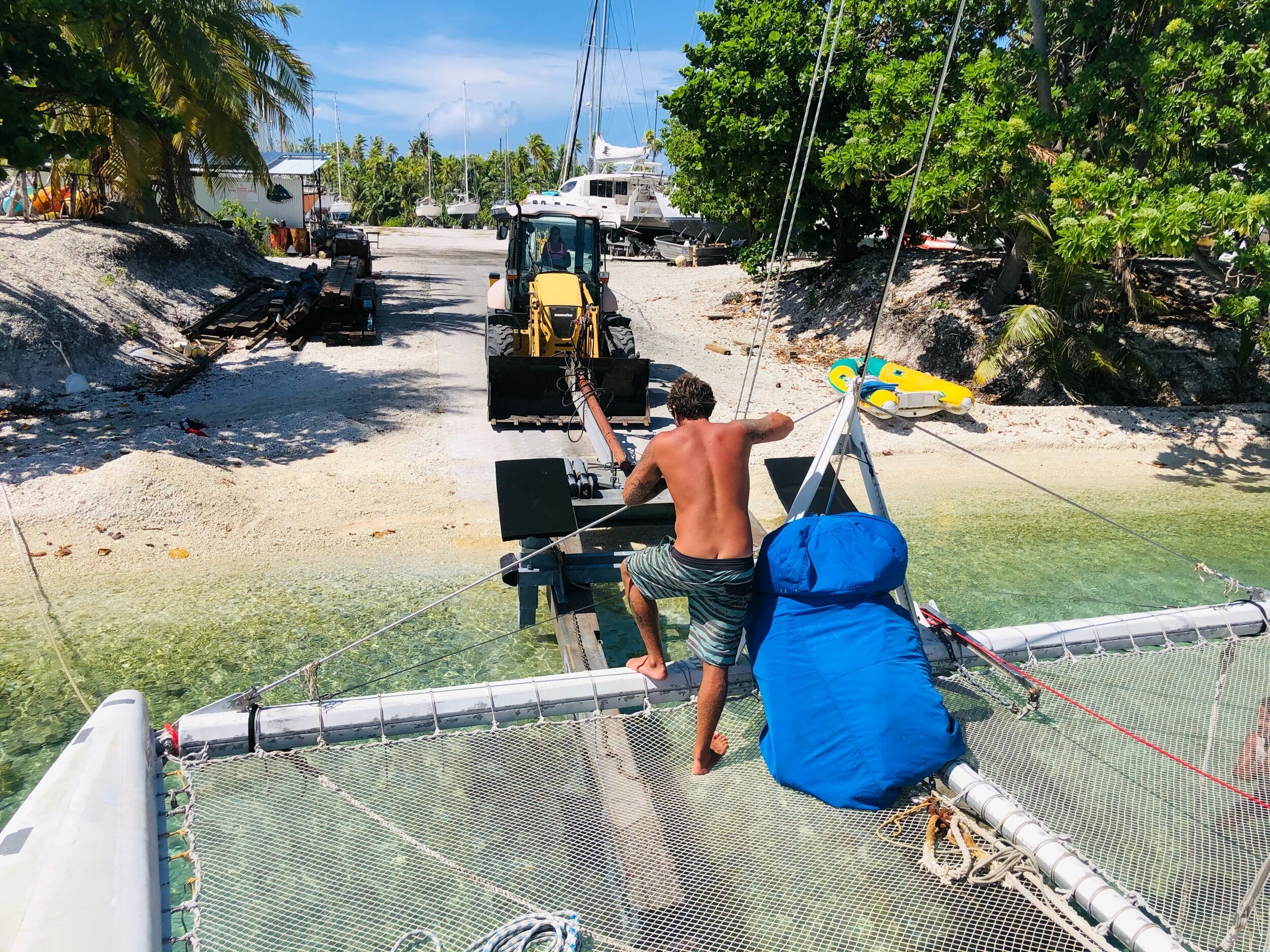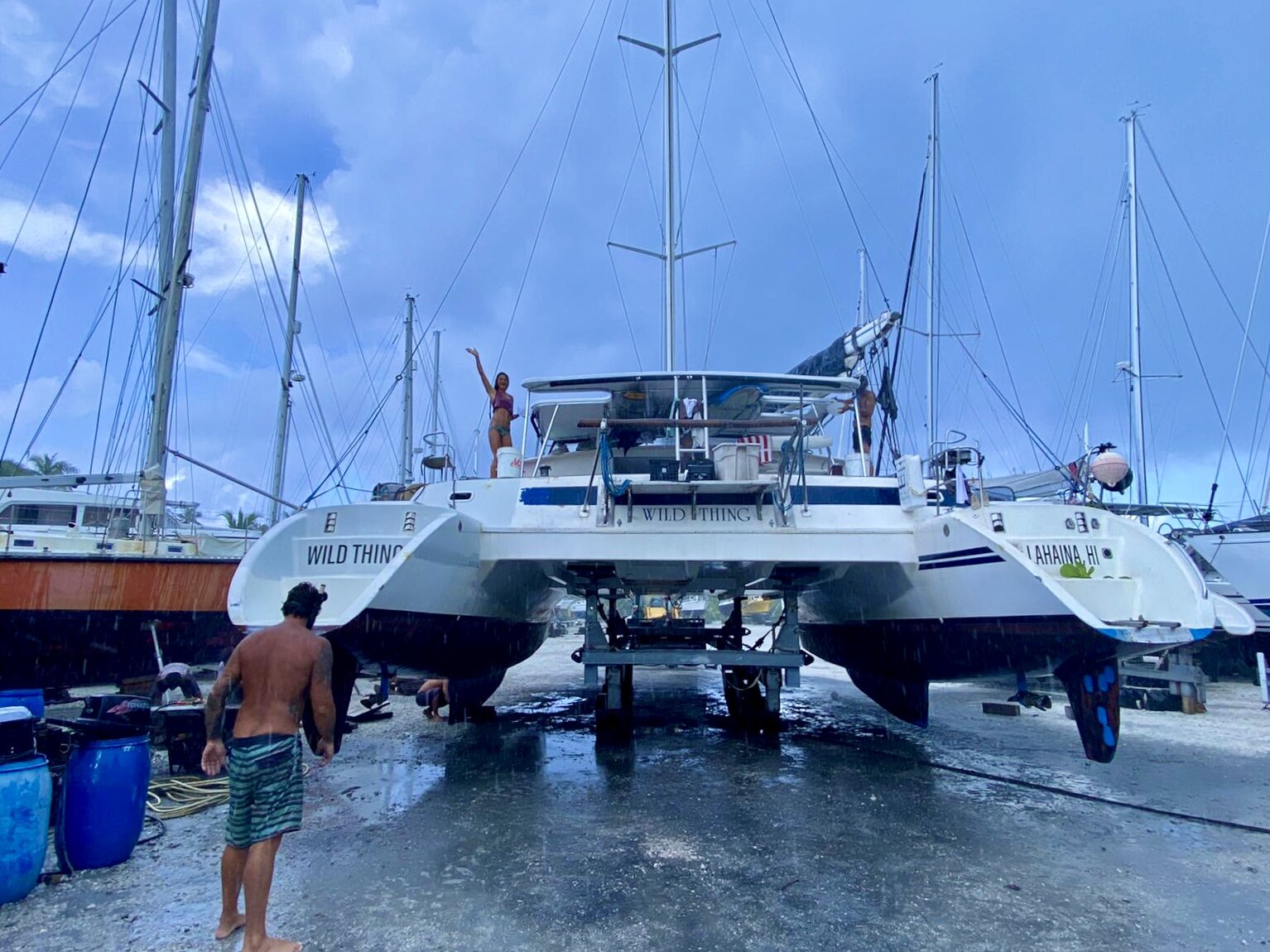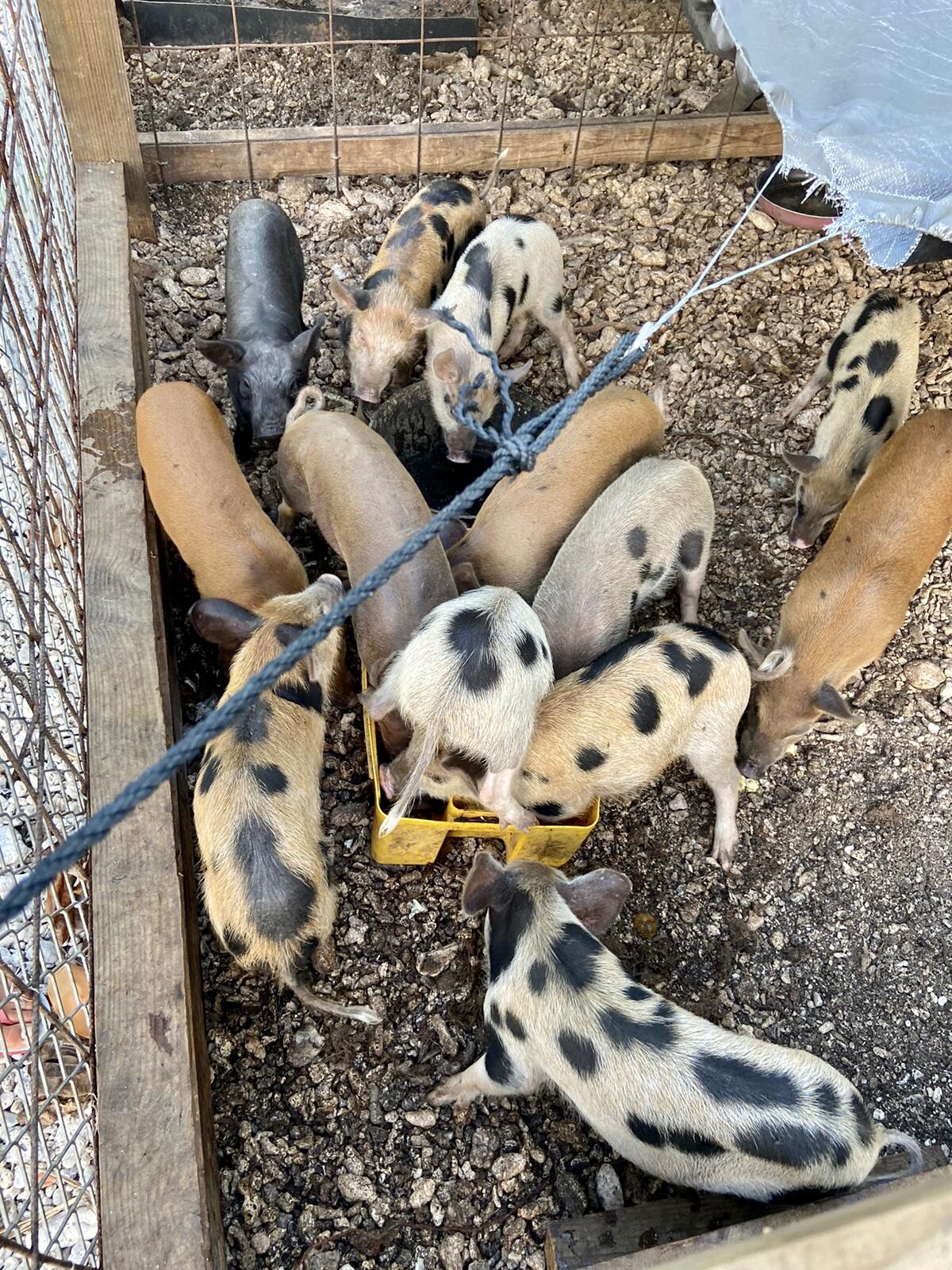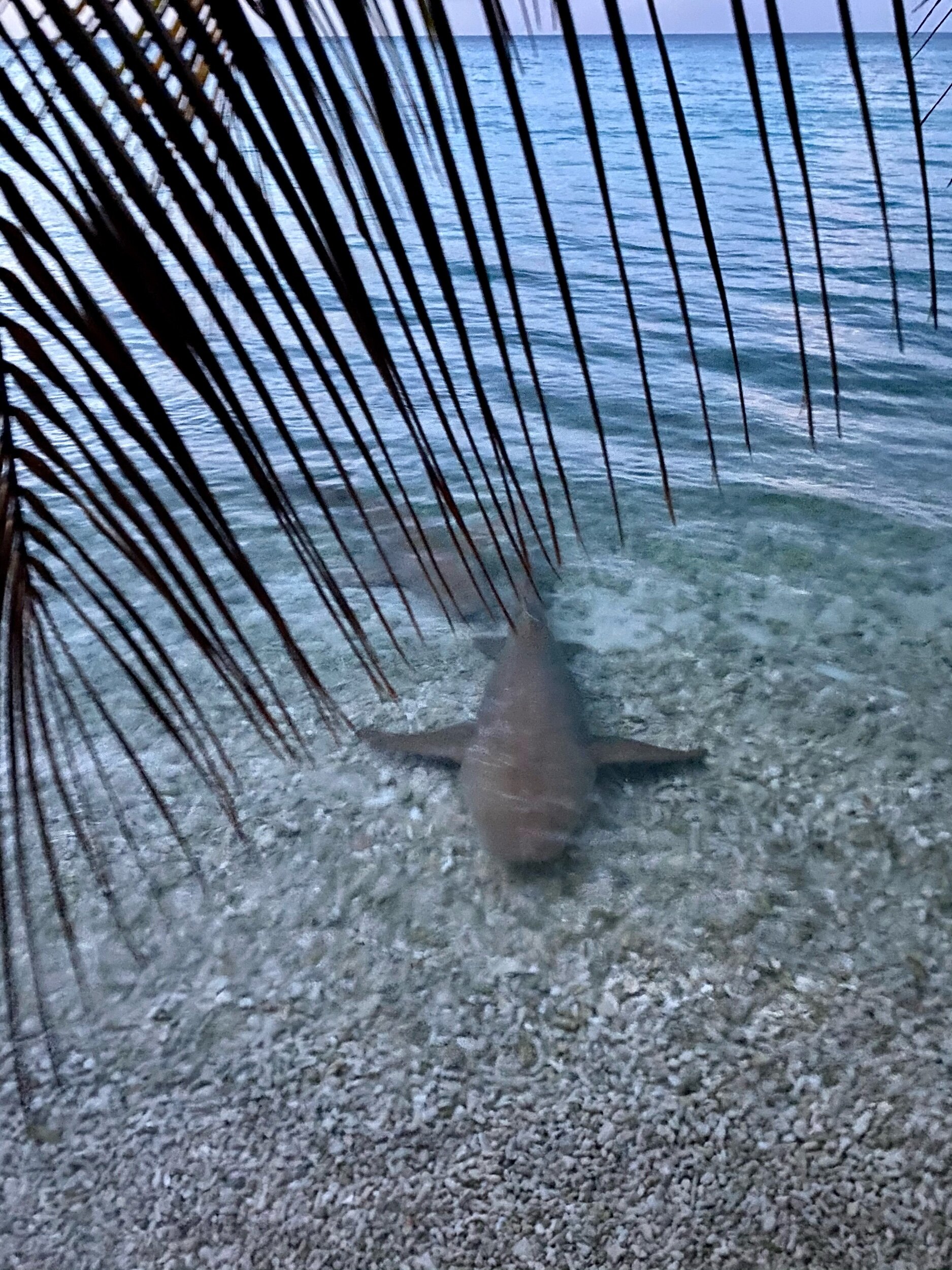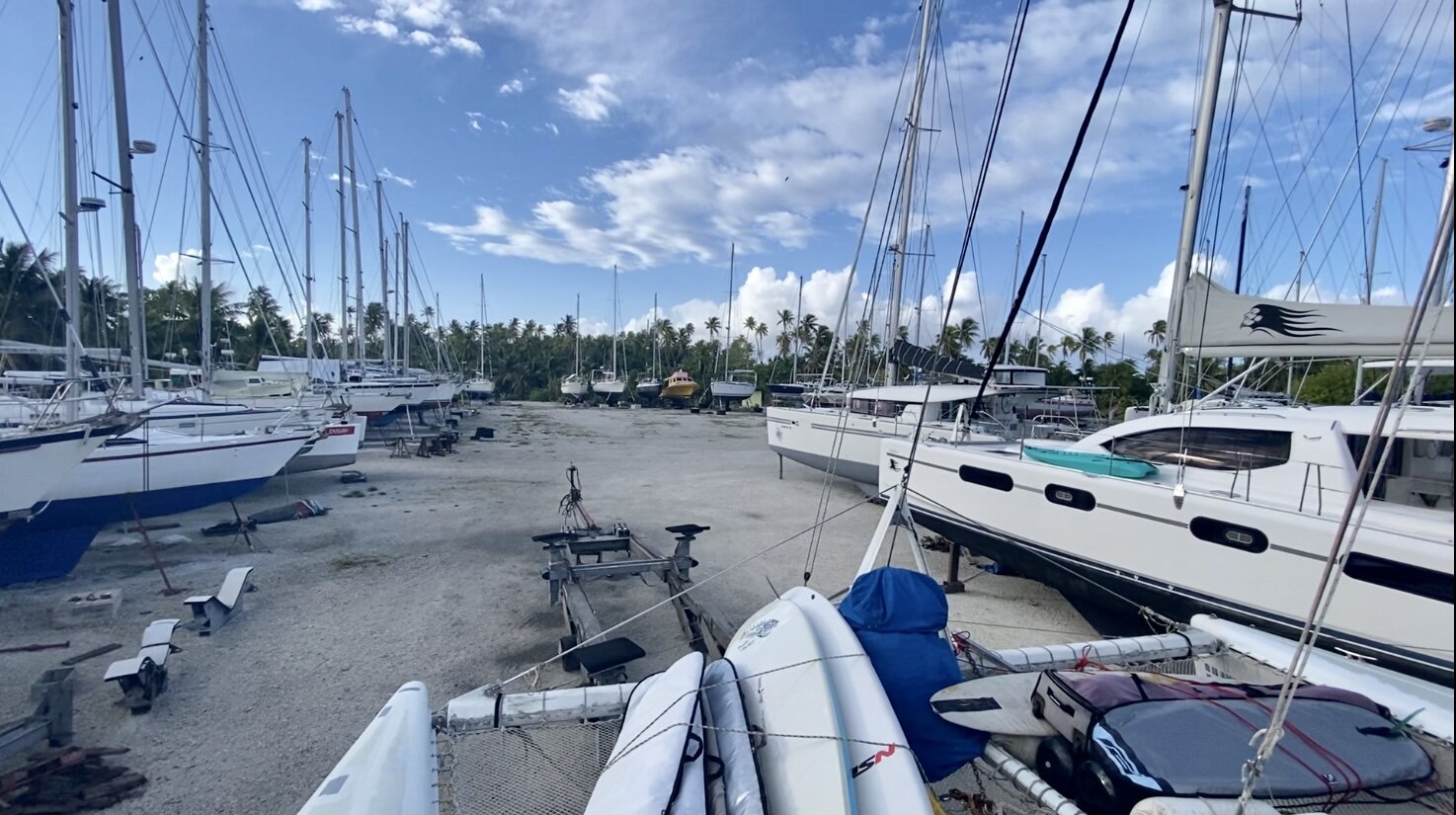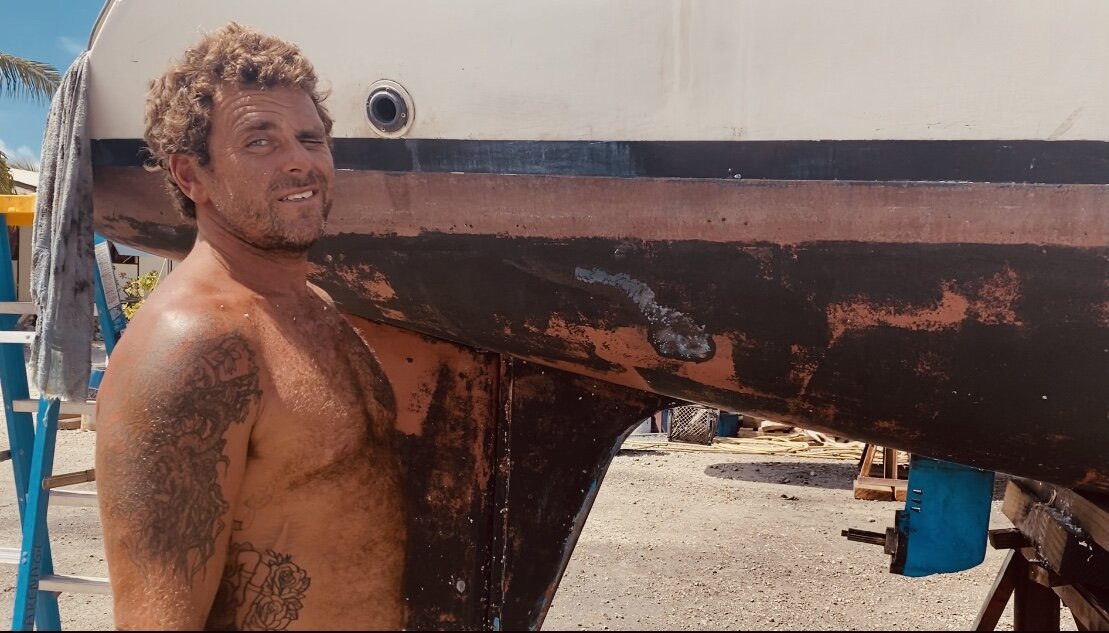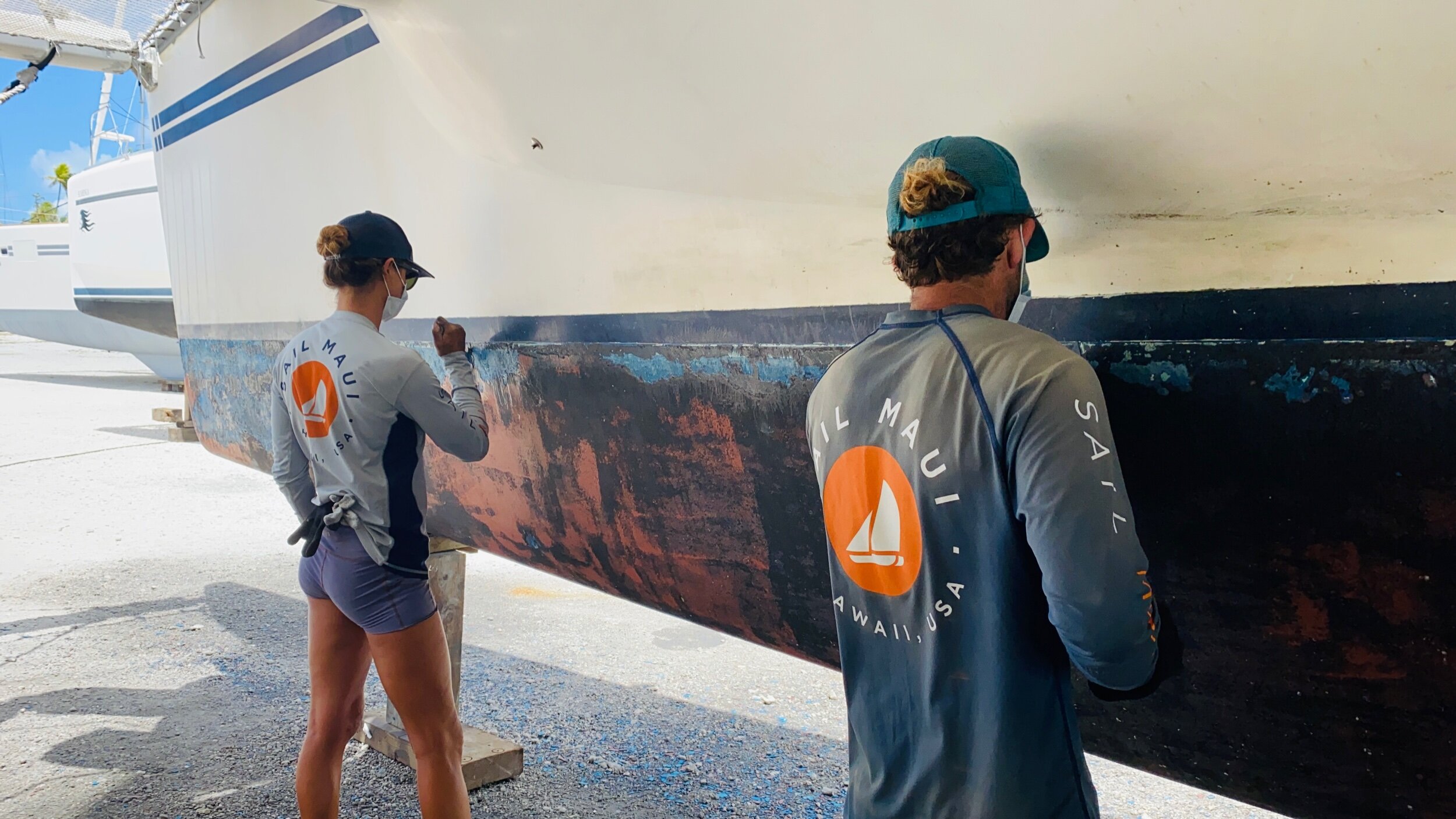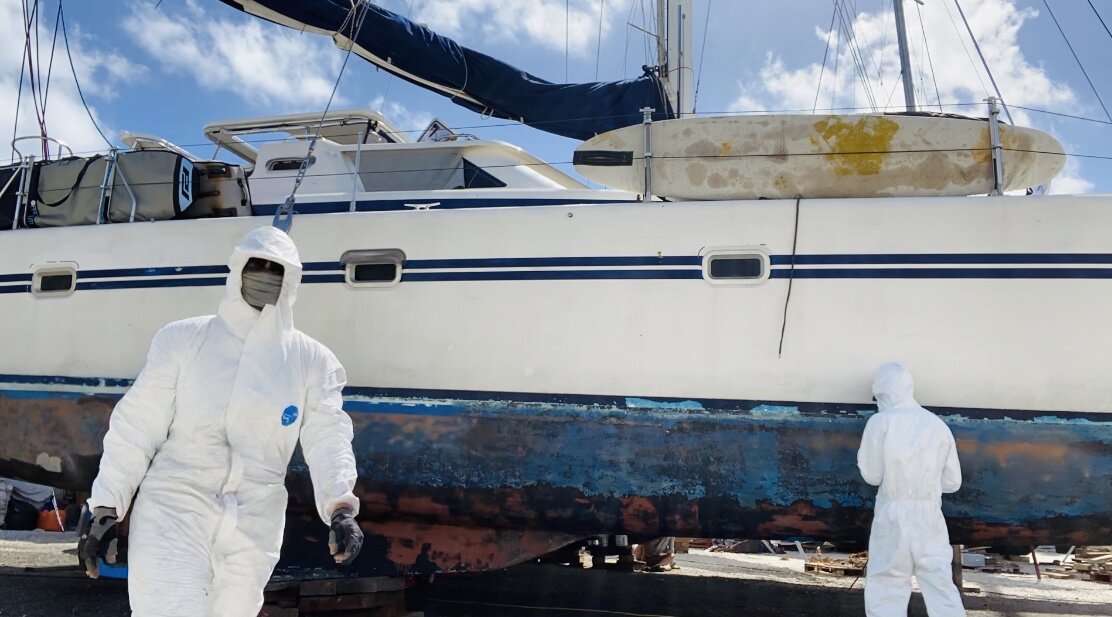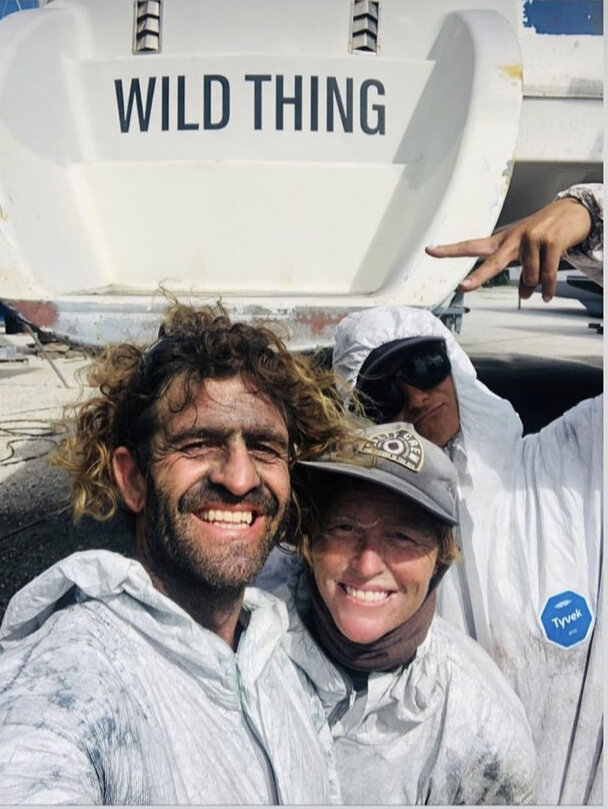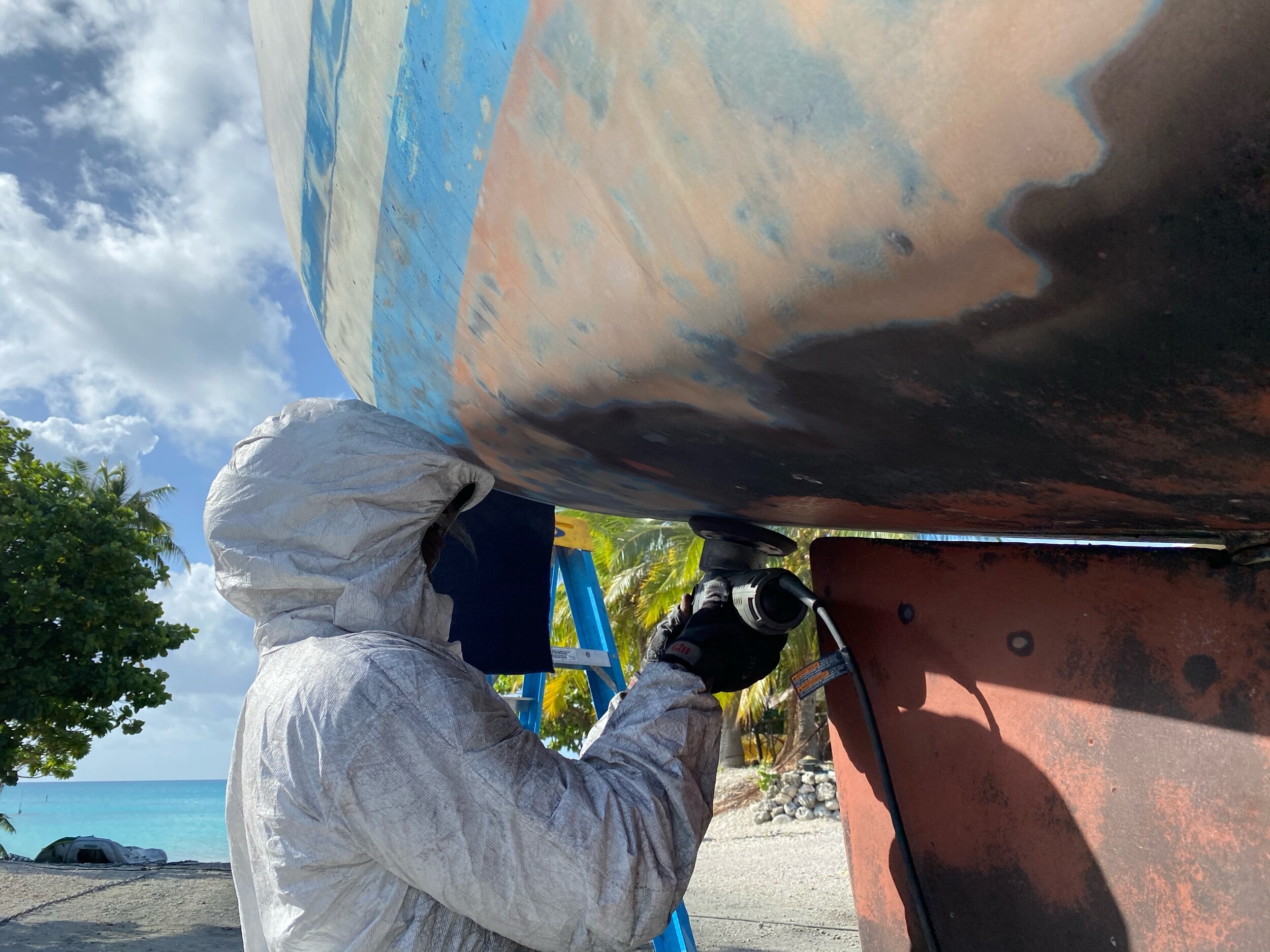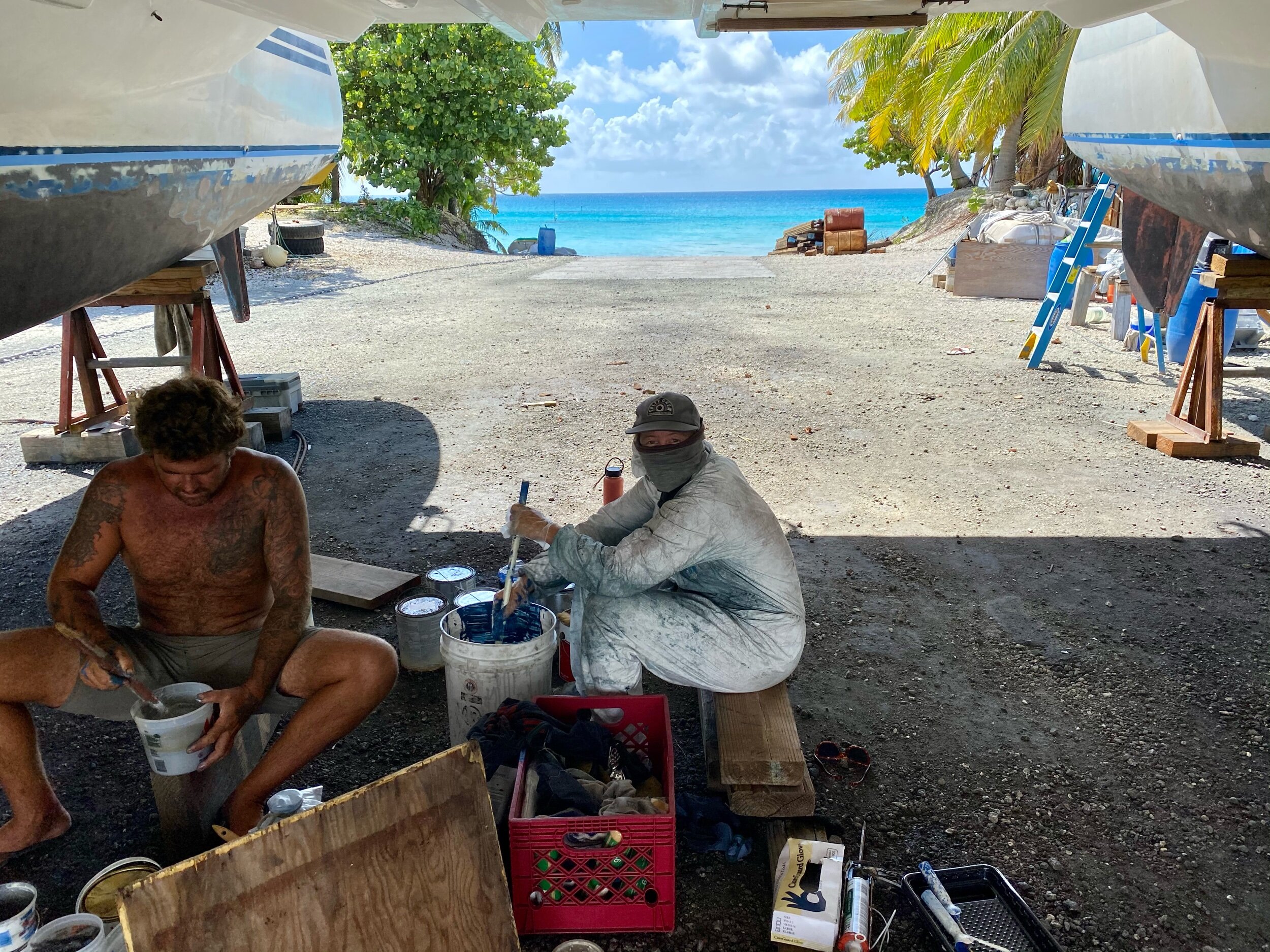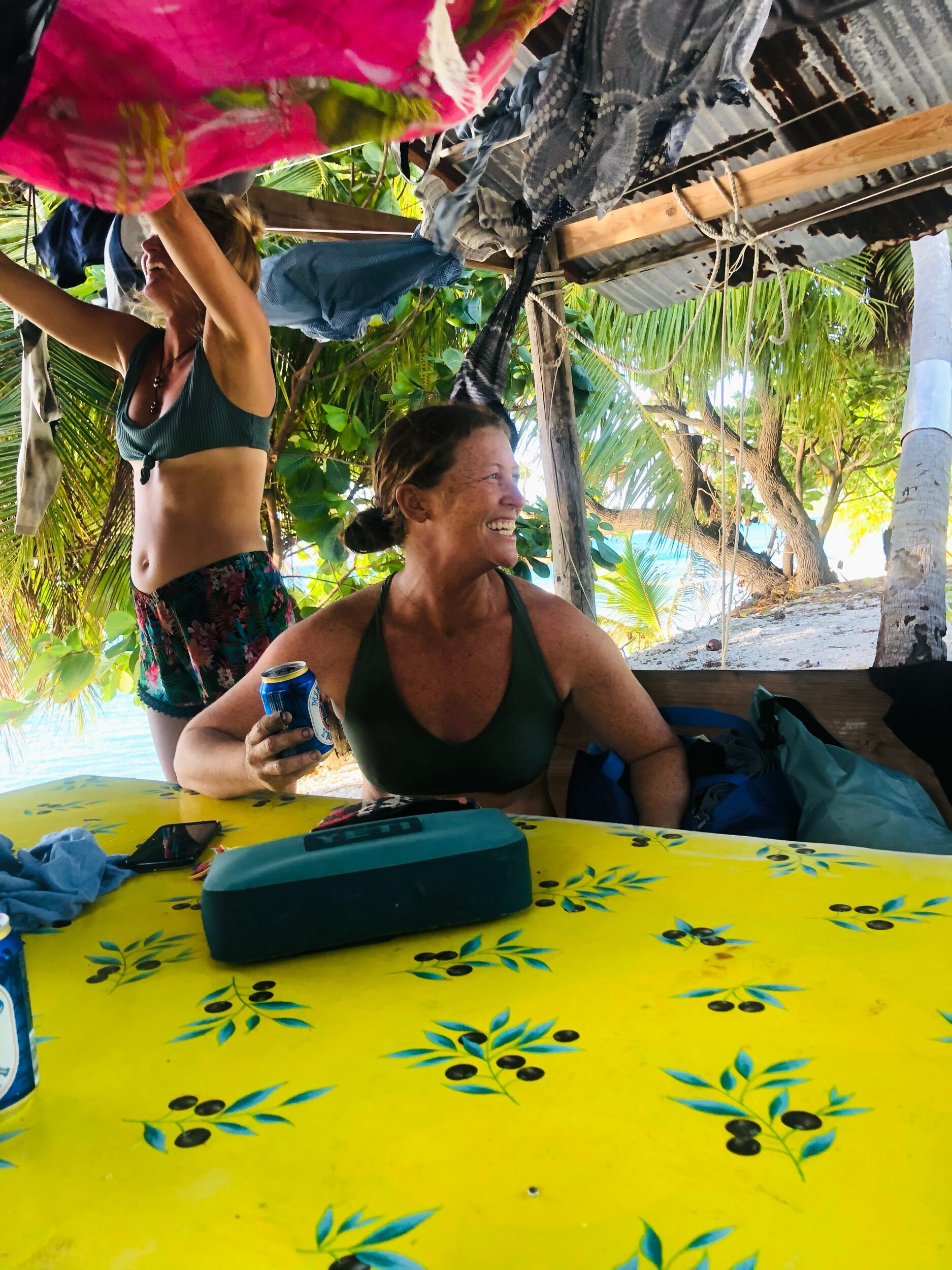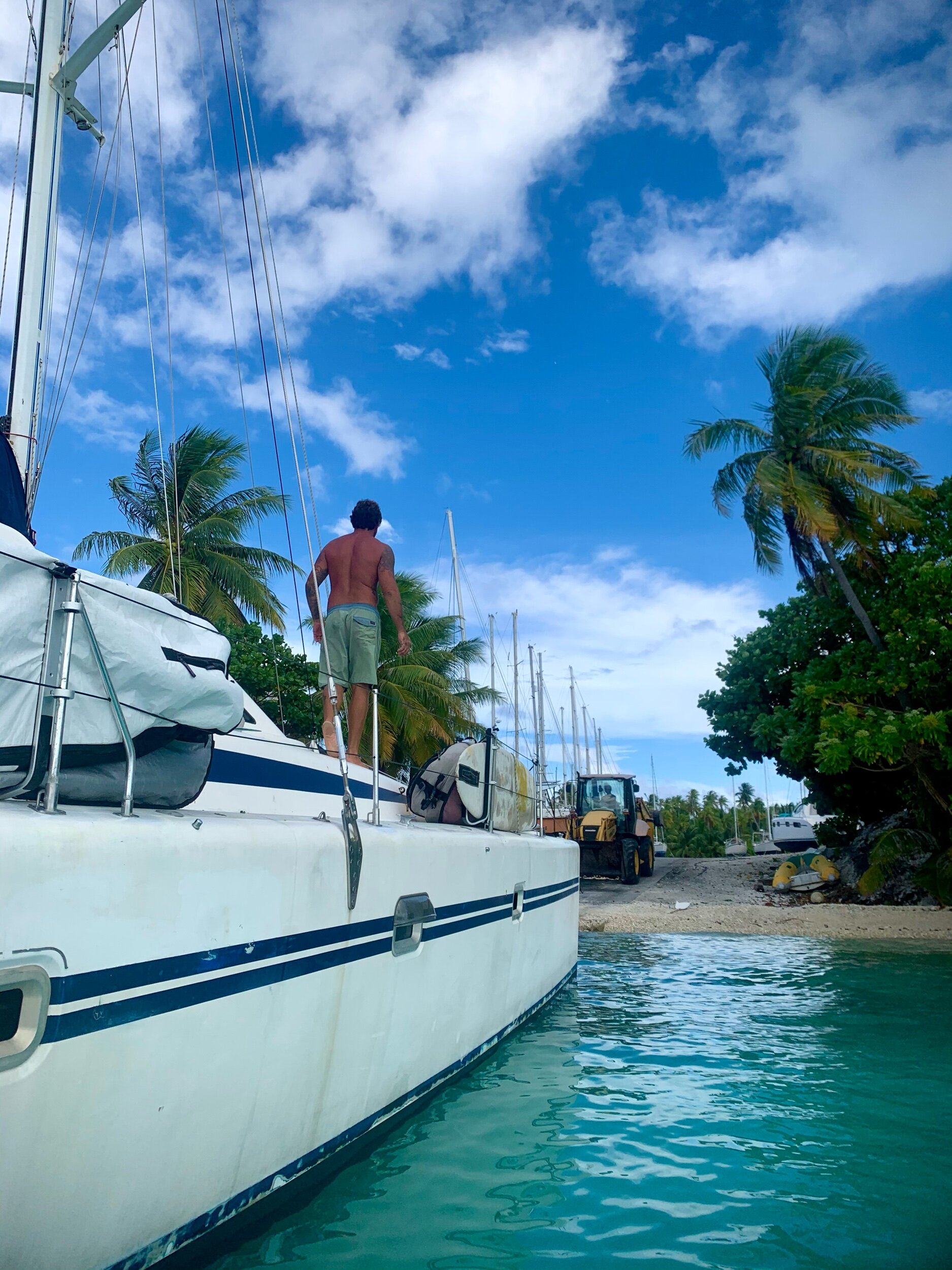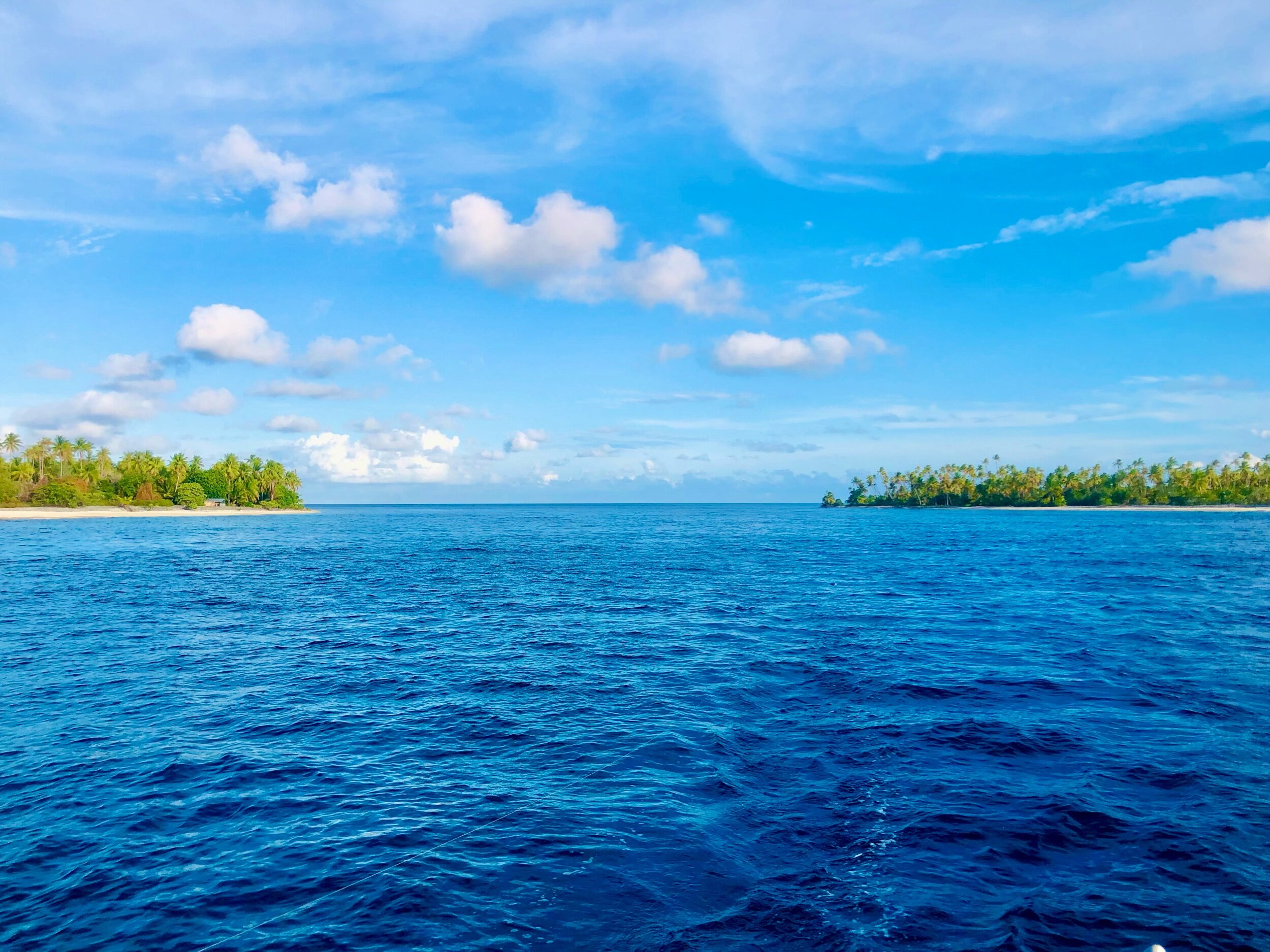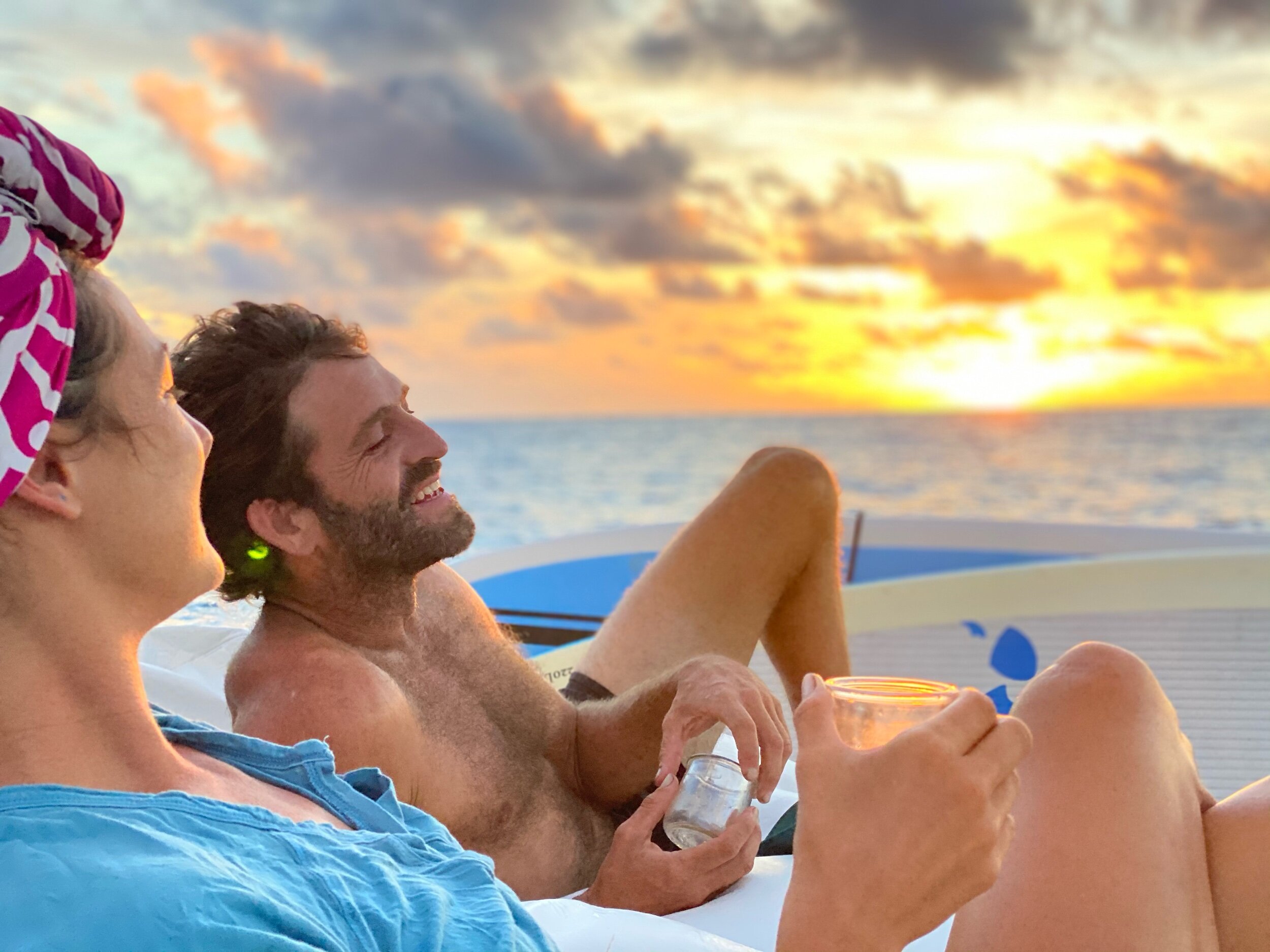A Week on the Hard
The first thing I noticed after being hauled out by the Komatsu tractor was how solid everything felt. The fiberglass deck felt stiffer. The top-loading refrigerator door felt heavier. Even the walls of Wild Thing felt more rigid. Within a matter of minutes, our home transmuted. It no longer ebbed and flowed and undulated with liquid movements. It was now docked on the dry, dense, fixed substance of land.
To soothe the transition, Tāwhirimātea, the Polynesian god of weather, blessed us with a downpour just as the stern peeled off the shoreline. Still aboard, we gathered every available vessel to harvest the precious resource that, all of a sudden, felt scarce. Out at sea, we were able to run our Spectra water maker everyday. This was literally the cornerstone of our off-grid, sovereign sea lives. On the hard, however, suspended three feet in the air by wooden blocks, many of our sustainable systems for survival were rendered useless.
Thankfully, our new terrain came equip with motu versions of closed-loop, sustainable systems. There was a hose for washing dishes, which pulled water from cisterns at the top of the property. The same waterlines ran to fancy new plywood sheds for showering and sophisticated outhouses with flushing toilets. Like most local homesteads, electricity was powered by solar energy. And, because nothing goes to waste in these barren lands, our food compost was re-purposed to a pen of piglets, while our fresh-caught fish scraps went straight to the resident nurse shark.
The Apataki Carinage is primarily a storage yard, however they provide resourceful haul-out services for the entire eastern expanse of French Polynesia. Off-the-beaten path and beyond the reaches of convenience, this family-run boatyard is an oasis for sailors seeking refuge or compromised cruisers in a pinch. The next closest boatyard is in Tahiti, 250 miles away. However, if you’re not already privy to the hospitable reality of this earthen harbor, it’s a destination worth discovering— a hidden gem in the rough & tough Tuamotu region.
Due to the relaxed influx of clientele and our forecasted quick turn-around, the Komatsu tractor dropped us dead-center of the boatyard’s main thoroughfare. Now, instead of sliding off the sugar scoop into the weightlessness of the sea, we carefully stepped onto an eight foot ladder that mercilessly reminded us of gravity.
Beyond the footprint of our beloved Wild Thing, a fleet of forsaken vessels lined the circumference of the coral studded yard. The bows of boats from all over the world faced inward, their freeboards paralleling each other like allies uniting for a common cause. They stood in patient resolution to withstand the deteriorating realities of time. And, maybe to recount their maritime stories by starlight— elusive whispers I strained to decipher every night as the wind howled through the cloud of shrouds beneath the waxing moon.
While we still slept on the boat by night, we worked under the boat by day. Beneath her wide beam, we were granted shady cover as we tended the inside hulls. The outsides, on the other hand, were strategically tackled as her silhouette acted as a sun dial, casting shadows starboard by morning and port by afternoon.
Our main intention for the haul out was to refit Wild Thing with a sleek new coat of bottom paint. This required the removal of three preexisting layers, the equivalent of hundreds of pounds of protective coating imbued with the personalities of past owners, countless nautical escapades, and scars from coral confrontations. Our second project was resolving an engine repair saga.
Already due for a top-end rebuild, including a high pressure fuel system servicing, the starboard engine incurred some additional damage during the 17 day passage from Hawaii to the South Pacific. Rowdy seas and obnoxiously abrasive jolting caused the motor mount bolts to sheer right off. This unfortunately left us with only one working engine, but fortunately revealed a deeper-seated issue yet to be noticed. The sheered bolts exposed water where there shouldn’t be water. Somewhere, there was a hole where there shouldn’t be a hole. So, there were just as many layers to address on the interior as there were on the exterior.
Due to his expertise and the cramped confines of the engine room, Brian’s energy was dedicated to project number two. Buckets of his blood, sweat and swearwords replaced the puddles of salt water that finally dried up. But after two days of problem solving and two more of tinkering, his back-breaking labors proved fruitful.
Meanwhile, Kerstin was devoted to steering clear of the toxic reality of bottom paint. Equally arduous and imperative to the smooth flow of operations, her workload included: administrative troubleshooting, website updates, preparing lunch for the crew, and, most importantly, growing a baby. That left Bailey, Landon and myself to busting out project number one.
We started chipping away on the very first day, literally within hours of being hoisted into position. With paint chipper in hand, I worked from bow to stern, staying up-wind of the copper-speckled confetti expressing one last burst of purpose. The three of us moved in stride, dislodging as much bulk as possible without gauging the base layer.
This was all in preparation, I soon learned, for sanding. When boat people say bottom paint, what they really mean is bottom sanding. For, that’s the majority of the job. One day of chipping, four days of sanding— all for the satisfying finale of painting, which takes all of half a day (with three people working, mind you).
I’ve been told that, for my first haul out experience, I hit the jackpot. The location, the weather, the crew, the overall ambiance were idyllic. There was always enough wind to counter the hot-box affect of full-body Tyvek suites. The cleansing lagoon waters were just footsteps away, offering mid-day dips and sunset decompression spearfishing missions. And, for the record, we continued to eat like kings and queens, thanks to the ingenious artistry of avant-garde chefs aboard.
Silver linings aside, I won’t lie. It was exhausting work. It was unpleasant and uncomfortable and unnervingly toxic. I broke out in rashes from underestimating the strength of bottom paint dust and, despite fair warning, not wearing proper protection the first day. I furthered my irritations by applying undiluted tea tree oil on itchy no-no bites, which caused burns instead of relief. Every night, I collapsed in bed feeling utterly worked and woke up the next morning feeling wrecked, my eyes puffy from vexed sleeplessness and swollen from being poisoned.
As the week wore on, I began to understand the undertone always associated with being on the hard. Haul out horror stories were told like battles lost and won: crusades into the mechanisms of ships, maritime modification and the mind. From what I could gather, hauling out seemed more or less like an initiation, a paying of dues, an inescapable reality of boat life.
Towards the end of the week, it all sunk in. I reached my breaking point, that tender moment in time when the hardened shell of perseverance buckles under the pressure of pride. Up until that point, I hadn’t even realized I’d created a shell. But there it was, cracking around me as my tears melted fears into truth. Unashamed, I ceased sanding and rested my head on the crude fiberglass surface. I closed my burning eyes and collapsed into my breath. All my walls came crumbling down. There, bare as the hull I rested my head upon, I realized my fragility. I felt naked and raw and utterly exposed, despite the full-body Tyvek armor that covered me from head-to-toe.
This was all so new to me. I had no idea what I was doing. Yet I had somehow convinced myself it felt natural enough to merit confidence— just enough confidence to subdue the fear, the vulnerability, the feeling of being alone in a whole new world.
While that confidence may have served a purpose, for it may have allowed me to blindly step onto this boat and into this voyage, it was no longer necessary. It was time to let down my guard, to get a little more real. It was time to reveal the parts of myself that I was withholding or protecting or trying to cover up. Even if this was all new to me and I had no idea what I was doing, that’s okay. It’s okay to be fragile and fresh, all bright-eyed and bushy-tailed and perpetually curious. It’s okay to just be me.
After facing my inner battle on the hard, the rest of the haul out was a down-hill slide to the finish line. All the chipping away and sanding down, however uncomfortable and challenging, left me feeling layers lighter. We donned Wild Thing with her fresh coat of bottom paint on Sunday and splashed back into the sea on Monday. She instantly felt different. She glided through the water swiftly and with more grace. She even sounded different, the splash against her hulls more crisp and coherently pitched.
Blessed again by Tāwhirimātea, favorable winds filled our sails as we set our course north to Ahe. We crossed through Tehere, Apataki’s northern pass which translates to “the love” just as sunset started to illuminate the sky. I was beside myself. The sky, the sea, the sexy sway of infinite waves. I jumped up to the bow-sprit and began counting my blessings. My gratitude was brimming overboard. Everything felt right. I rolled back onto the nets and was met by my mates, who smirked at my unbridled enthusiasm, but nonetheless shared my sentiment. I wasn’t the only one who faced battles in the yard.
That night, as the full moon rose over a pastel horizon, we celebrated our successes, both individual and collective. Our realized liquid freedoms were more palpable than ever. With glasses of rosé in hand, we toasted to the sensations of our sailing life that could only be heightened by a week on the hard.


